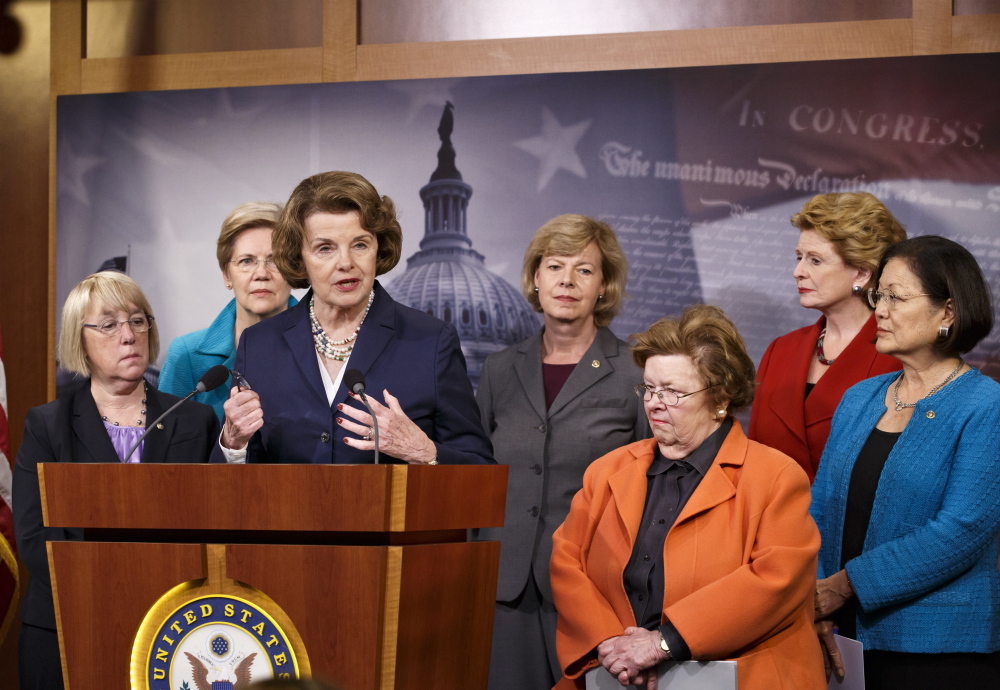The Washington Post crunched the numbers last year and found that, mathematically, “no Congress in 40 years has been paid more to pass less legislation.” It’s also a fact that Congress is heavily male. The current Congress has a record 104 women – but that’s 104 of 535 lawmakers in all. But what if the two facts are connected – that men are less likely to introduce legislation and cut deals than women? It turns out women have been considerably more likely than their male counterparts to get bills through, and to achieve that near-unicorn of modern Washington: bipartisan agreement.
The numbers, as published Thursday by a new startup called Quorum, founded not a month ago by two Harvard seniors, seem to bear this out. Over the last seven years, in the Senate, the “average” female senator has introduced 96.31 bills, while the “average” male introduced 70.72. In the House, compare 29.65 for women, and 27.2 for men. And women were more likely to gain co-sponsorship: In the Senate, women had an average of 9.10 co-sponsors, men 5.94. In the House, the difference was smaller, but women still proved better at sponsoring together: Female Representatives averaged 16.84 co-sponsors, and men 14.64.
There are effective female dealmakers from both sides, though more are Democrats, probably because there are more Democratic female members of Congress. In the Senate, Quorum’s co-founders, Alex Wirth and Jonathan Marks, said Dianne Feinstein has sponsored the most bills of any female senator: 300. Amy Klobuchar is next, at 215, then Kirsten Gillibrand 204, Barbara Boxer 176, and Patty Murray 126. In the House, Sheila Jackson Lee leads, with 177, then Carolyn Maloney at 163, Eleanor Norton a 136, Barbara Lee at 96, and Rosa DeLaura at 91. Sen. Boxer has had the most sponsored bills enacted, 10, followed by Feinstein and Klobuchar (both seven), then Patty Murray and Lisa Murkowski. In the House, Reps. Norton and Maloney lead, and then Ileana Ros-Lehtinen, Nydia Velázquez, and Ann Kirkpatrick.
Women are also more likely to co-sponsor with other women than men are with other men. From the 111th Congress to the present one, the typical female senator cosponsored 6.29 bills with another female senator, as opposed to 4.07 bills cosponsored by male senators with a male peer. Ironically, one contributing factor may be that the limited number of women helps create strong bonds that facilitate collaboration. Trend pieces have been written before about the supper club of bipartisan female senators who meet monthly at each other’s places, or in the Capitol’s Strom Thurmond room. Sen. Barbara Mikulksi started it; she told Margaret Carlson some years ago that the members call her Coach Barb. She said, “When a new woman is elected to the Senate – Republican or Democrat – I bring her in for my Senate Power Workshop and guide her on how to get started, how to get on the good committees for her state, and how to be an effective senator.” It could be a coincidence that Mikulski has a high average number of co-sponsors for bills in the Senate. Sens. Shelley Capito, Tammy Baldwin, Elizabeth Warren and Mikulski all average more than 10 co-sponsors per bill. Or it could have something to do with a sense of camaraderie. (For the House, Terri Sewell led, at 64, and then Anna Eshoo, Katherine Clark, Louise Slaughter and Kay Granger.)
There’s also an unusual streak of bipartisanship. Susan Collins co-sponsored a whopping 740 bills with opposite party sponsors. Lisa Murkowski co-sponsored 445, Kelly Ayotte 217, Klobuchar 200, and Mazie Hirono 172. (The dinner group may have helped, at least in the cases of Klobuchar, a Democrat, and Murkowski, a Republican. They may have political disagreements, but, Klobuchar told Carlson, “But when we went on family vacation to Alaska. Lisa had us over to her house.”) In the House, Rep. Ros-Lehtinen cosponsored 458 bills that had an opposite party sponsor. Norton, Maloney, Madelein Bardallo and Zoe Lofgren were also active on that front.
Yes, it could be the need for banding-togetherness, against an overwhelming male majority, that makes women masters of deals. It could also be something about women, or how women are conditioned.
Copy the Story LinkSend questions/comments to the editors.




Success. Please wait for the page to reload. If the page does not reload within 5 seconds, please refresh the page.
Enter your email and password to access comments.
Hi, to comment on stories you must . This profile is in addition to your subscription and website login.
Already have a commenting profile? .
Invalid username/password.
Please check your email to confirm and complete your registration.
Only subscribers are eligible to post comments. Please subscribe or login first for digital access. Here’s why.
Use the form below to reset your password. When you've submitted your account email, we will send an email with a reset code.